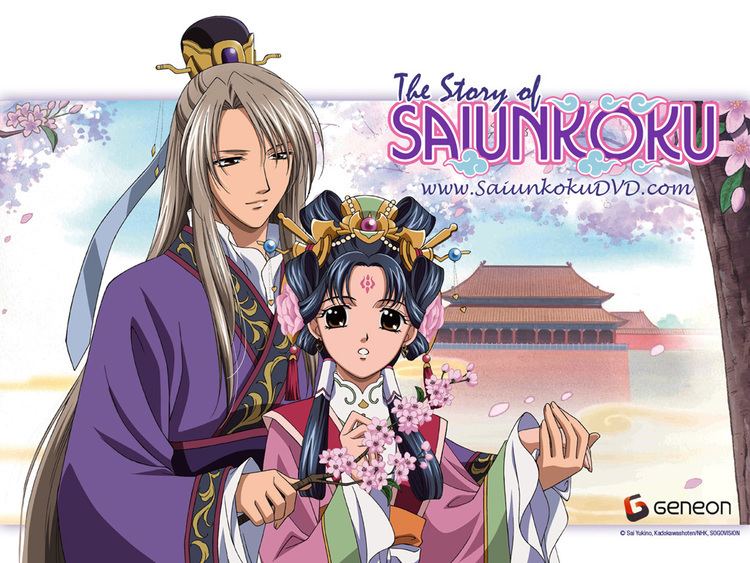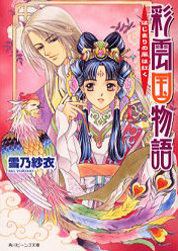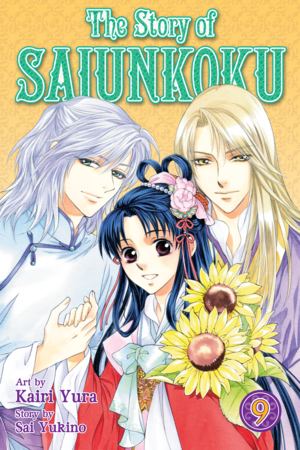Demographic Female Original run 2003 – 2011 | Illustrated by Kairi Yura Imprint Beans Bunko | |
 | ||
Published by Kadokawa ShotenSeoul Media Group Genres Fantasy, Romance novel, Comedy | ||
Manga collection the story of saiunkoku
The Story of Saiunkoku (彩雲国物語, Saiunkoku Monogatari, literally "Tale of the Kingdom of Colored Clouds") is a series of Japanese light novels written by Sai Yukino and illustrated by Kairi Yura. As of July 2011, the eighteenth and final volume was released, concluding the series. Four side story anthologies have also been released, collecting stories originally published in The Beans magazine.
Contents
- Manga collection the story of saiunkoku
- The story of saiunkoku episode 10
- Story
- Setting
- Light novels
- Side stories
- Manga
- Anime
- Soundtracks
- Drama CDs
- Other
- References
A manga version, also illustrated by Kairi Yura, is serialized in Beans Ace, which is published by Kadokawa Shoten. However, when Beans Ace ended, the manga was moved to Monthly Asuka. Currently, nine tankōbon volumes have been released. The series has been licensed by Viz Media for an English release in North America as part of their Shojo Beat imprint.

The anime adaptation series, produced by Madhouse Studios, is directed by Jun Shishido, and broadcast on the Japanese television network NHK on Saturday mornings. The first season began airing on April 8, 2006, and completed its run on February 24, 2007, airing a total of 39 episodes. The second season, titled Saiunkoku Monogatari Second Series (彩雲国物語 第2シリーズ) began airing on April 7, 2007 and consists of another 39 episodes, ending its run on March 8, 2008.

The story of saiunkoku episode 10
Story
Saiunkoku is a world of eight provinces or houses, each named after a different color.
Set in the fictional empire of Saiunkoku, the story centers on Shurei Hong (Kou), a descendant of a noble family that has fallen on hard times. Her father works as a librarian in the Imperial palace, a post which offers prestige and respect, but little compensation. Shurei teaches in the temple school and works odd jobs to make ends meet, but her dream is to pass the imperial examinations and take a post in government, a path forbidden to women.
The new Emperor, Ryuuki Shi, has gained a reputation for being uninterested in courtly matters and for flaunting his love for men. So the Emperor's Grand Adviser makes a startling offer for her to join the imperial household for six months as the young Emperor's consort and teach the Emperor to be a responsible ruler. She easily accepts the invitation as she will receive a reward of 500 gold coins if she succeeds. The mysterious Seiran, a young man who was adopted by her father, goes with her as Ryuuki's bodyguard. Entering the imperial palace revives Shuurei's dream of being a court official.
The story details the hardships of creating change, especially as a woman, Shurei's growing relationship with the Emperor and other members of the court, the intrigues of imperial politics, and her commitment to better herself and her country.
Setting
According to legend, Saiunkoku was once infested by demons who threw the country into turmoil. A brave young warrior named Gen Sō (蒼玄, Sō Gen) gathered together the Eight Enlightened Sages of Color and drove away the demons.
Sō Gen then forged the nation of Saiunkoku and became its first emperor. After Sō Gen's death, the eight sages disappeared, but according to legend they still exist among the people. A beautiful shrine was built for the Eight Colored Sages and still stands within the Imperial City.
Saiunkoku had always been divided into eight provinces named after colors of the rainbow. Six hundred years ago, the Emperor commanded each ruling clan to change its name to match its province. Commoners were forbidden to use the same family names as nobles.
Light novels
Written by Sai Yukino and illustrated by Kairi Yura, the light novel series The Story of Saiunkoku has been serialized in The Beans since 2003. The individual chapters are collected and published in full novel volumes by Kadokawa Shoten with the first volume released in Japan on October 31, 2003. As of April 2010, 16 volumes have been released for the series.
Side stories
Sai Yukino has written a series of short side stories for The Story of Saiunkoku which are published in collected volumes by Kadokawa Shoten. The first volume was released in April 2005; as of May 2009, four volumes have been released.
Manga
Written by Sain Yukino and illustrated by Kairi Yura, a manga adaptation of The Story of Saiunkoku began serialization in Beans Ace in 2005 where it continues to run. However, on October 9, 2009, the magazine ended its publication and the series continued in Monthly Asuka till 2012. The individual chapters are published in tankōbon volumes by Kadokawa Shoten, with the first released in June 2006. As of April 2012, nine volumes have been released. The series has been licensed by Viz Media for an English release beginning in November 2010.
Anime
Produced by Madhouse Studios and directed by Jun Shishido, the anime adaptation of The Story of Saiunkoku premiered in Japan on NHK on April 8, 2006. The first season ran for 39 episodes until its conclusion on February 24, 2007. The second season, referred to as Saiunkoku Monogatari 2nd Series, premiered on April 7, 2007 and ran for another 39 episodes until its conclusion on March 8, 2008.
In May 2007, Geneon Entertainment announced it had acquired the license to releases the anime in North America with English language options. In September 2007, after only two volumes had been released, Geneon closed its North America operations. In July 2008, Funimation announced that it will distribute several Geneon titles, including The Story of Saiunkoku.
The series uses three pieces of theme music. "Hajimari no Kaze" (はじまりの風, lit. "Wind of Beginnings") by Ayaka Hirahara is used for the opening theme for both the first and second seasons. For the ending theme, "Saikō no Kataomoi" (最高の片想い, lit. "The Greatest Unrequited Love") by Sachi Tainaka is used for the first season, while "Asu e" (明日へ, lit. "To Tomorrow") by Teruya Miho is used for the second season.
Soundtracks
Three CD soundtracks have been released by Geneon Entertainment for The Story of Saiunkoku, using music from the anime adaptation. The Story of Saiunkoku Original Soundtrack (彩雲国物語 オリジナルサウンドトラック 1) was released on August 4, 2008 containing 38 individual tracks, including the television length opening and ending themes. The second followed on January 12, 2007 with an additional 30 tracks. On December 7, 2007, a third soundtrack, The Story of Saiunkoku Second Series Original Soundtrack (彩雲国物語セカンドシリーズ」オリジナルサウンドトラック), was released containing 23 tracks from the second season of the series. The two series ending themes were released to CD singles on August 30, 2006 and June 6, 2007, respectively. On March 7, 2008, an additional CD soundtrack, Song of Memory was released containing 10 tracks with various character image songs.
Drama CDs
Three drama CD series have been created around The Story of Saiunkoku. The first series, The Story of Saiunkoku Drama Bangai (彩雲国物語 ドラマ), spanned three volumes and covered the first season of the anime. The first volume was released on September 8, 2006; the second and third volumes followed on November 10, 2006 and March 9, 2007, respectively.
The second series, The Story of Saiunkoku Anime Drama Dai ni Kan (アニメ「彩雲国物語」ドラマCD 第二巻), also spanned three CDs which were released between August 25, 2006 and December 21, 2007.
The final three volume series, The Story of Saiunkoku Second Series Drama Bangai Hen (彩雲国物語セカンドシリーズ ドラマ 番外編), covers events from the second series of the anime. The first volume was released on September 7, 2007, with the remaining volumes following on November 9, 2007 and February 2, 2008.
Other
A web-based radio program for the series aired in Japan. Hosted by Tomokazu Seki and Hikaru Midorikawa, the program included mini-stories and special guests discussion the series. The program was released across two CDs in Japan by Geneon Entertainment. The first was released on May 25, 2007 with the first seven broadcasts and a bonus track. The second CD, containing the remaining six broadcasts and a bonus character song, was released on October 24, 2007.
On August 28, 2007, an art book for The Story of Saiunkoku was released in Japan. The Story of Saiunkoku Picture Scroll (彩雲国物語 絵巻, Saiunkoku Monogatari Emaki) included art work from series illustrator Kairi Yura, episode summaries for the first season of the anime adaptation and a bonus short story by author Sai Yukino. A second art book, The Story of Saiunkoku Picture Scroll 2 (彩雲国物語 絵巻, Saiunkoku Monogatari Emaki 2), was released on June 10, 2008 containing more art work for the series, as well as episode summaries from the second anime season and another bonus short story.
